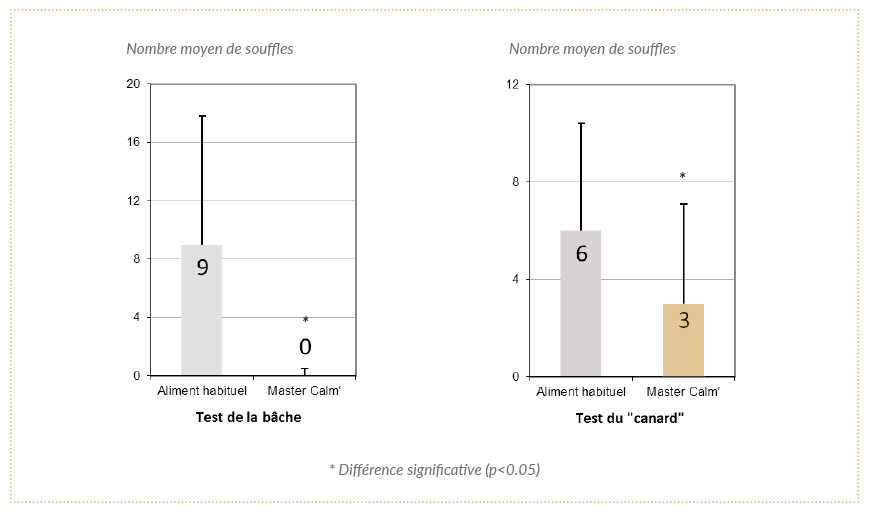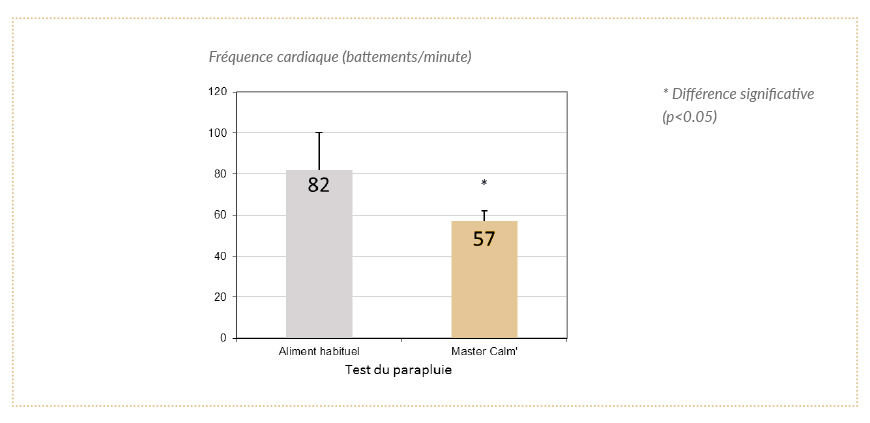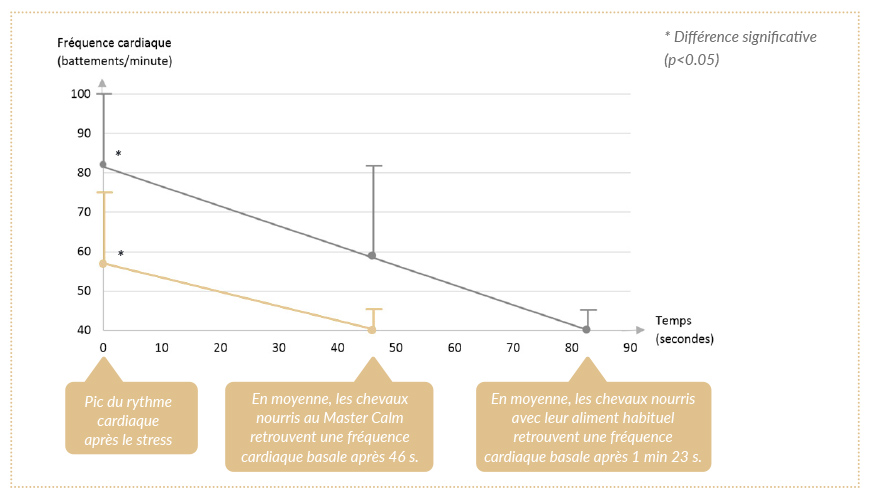Aucun produit
Bienvenue sur le site Lambey
Sélectionner votre pays
Bienvenue sur le site Lambey
Sélectionner votre pays
Catégories de Blog
Derniers Posts
Une forte réactivité, une grande émotivité ou des réactions de peur chez le cheval, de sport et de loisir, peuvent engendrer des problèmes de sécurité. De plus, le travail du cheval peut être perturbé par un comportement nerveux. Des études ont montré que l’alimentation pouvait modifier le comportement.

Une forte réactivité, une grande émotivité ou des réactions de peur chez le cheval, de sport et de loisir, peuvent engendrer des problèmes de sécurité. De plus, le travail du cheval peut être perturbé par un comportement nerveux. Des études ont montré que l’alimentation pouvait modifier le comportement.
Nous avons réalisé une étude scientifique pour démontrer l’efficacité de l’aliment Master CALM sur le comportement des chevaux nerveux.
Des chevaux nerveux au box, difficiles à maîtriser à la monte ou phobiques ont été sélectionnés.


Trois tests comportementaux ont été réalisés au box. Les chevaux ont été soumis à deux types de stress que sont la confrontation à la nouveauté et la soudaineté.
- Test de la bâche : une bâche est disposée au sol. Un seau d’aliment est placé à son extrémité. Le cheval doit poser ses antérieurs sur la bâche pour manger.
- Test du parapluie : Un parapluie automatique est ouvert brutalement à 1 m de la tête du cheval.
- Test du « canard » : un canard motorisé en plastique est posé sur un plateau. Il tourne et émet des bruits.

| Face à une situation de surprise, les pics de fréquence cardiaque sont moins élevés chez les chevaux nourris au Master Calm. |

| Face à une situation de surprise, les pics de fréquence cardiaque sont moins élevés chez les chevaux nourris au Master Calm. |

| Face à la nouveauté, les chevaux émettent des souffles de peur et des ronflements. Le nombre de souffles enregistré lors des tests est inférieur pour les chevaux nourris avec l’aliment Master Calm. Les chevaux alimentés avec du Master Calm sont moins effrayés. |
Les résultats de cette étude ont été sélectionnés par un comité d’experts internationaux pour être présentés lors du congrès de l’ENUTRACO (Applied Equine Nutrition and Training) à Paris :
« Effet d’un complément alimentaire pour chevaux sur le comportement des chevaux nerveux. »
M. Barbier ; S. Benoit ; J-L. Lambey
Home message: In this study, the Master CALM’ horsefeed has reduced intensity of behavioural responses to startle and novelty reactions. Moreover, feeding horses with Master CALM’ have influenced heart rate parameters. The lower maximal heart rates and weaker increase percentages indicated a reduction of stress level. Horses were less excited and quickly calmed down after exposure to fearfulness situation.
Introduction :
Within the scope of his using for sport and leisure, natural horse environment is changed. Specific living conditions of the horse like stable containment involve movement restrictions for horses and change social relationship. Horse management: work subjection, transport, and competition go against to natural horse lifestyle. All these factors are stress sources for the horse and may have effects on his behaviour, induce uncontrolled reactions (shying, bolting...), and even also develop chronic stress in anxious horses (Forkman et al., 2007). Fear reactions seem to appear more violent in nervous horses and cause physical injuries to himself and his user. These behavioral problems can also affect animal performance and spoil health (Hausberger et al., 2008; Hausberger et al., 2009). Previous studies have shown that diet could be an easy way to influence horse behaviour. The intake of large amount of starch and sugars has been suggested to cause excitable behaviour (Redondo et al., 2009) whereas dietary fats could improve reactivity of horses (Holland et al., 1996) with comparable intake of digestible energy (McKenzie et al., 2003). In this context, we have developed a new complementary horsefeed (Master CALM’) which aims at calming nervous horses.The objective of this study was to assess the effect of Master CALM’ on behaviour of nervous horses.
Materials and methods :
Subjects and management
17 jumping horses from 11 French stables were selected for this study because they were considered as difficult to handle or to ride by stable manager, instructor, coach or their owner in comparison to others in the same stable. They were kept in 12 m2 stall. These horses performed as jumpers or event horses and maintained consistent work levels throughout the study period 6-7 h/week.
Dietary treatment and experimental procedure
Horses were randomly allocated to 1 of the 2 diets that were tested in a parallel experimental design. They were fed with meadow hay and were complemented with concentrate horsefeeds in 2 or 3 meals depending on the stables (Table 1). The control diet consisted of the usual pelleted or flaked concentrate feed of the horses. The test diet consisted of Master CALM’ (Lambey SA, Torpes, France). The 2 types of horsefeed contained similar crude protein contents, but differed in the fat and starch balance, control horsefeeds on average 4.6% fat – 33.8% starch and test horsefeed 9.5% fat – 15% starch. Master CALM’ horsefeed is also enriched with vitamins B1, B2, C, E, magnesium and tryptophan. The amount of Master CALM’ was calculated to be iso-energetic with the usual horsefeed they received before. Water was available ad libitum in stalls. Horses have been fed with their diet for 6 weeks before the behavioural tests were performed.
Tests of temperament
Our study focused on fear reactions which are defined as the horse capacity to react to the perception of potentially threatening reactions (Boissy, 1995 ; Forkman et al., 2007). Three behavioural tests were established to characterize fear reactions when horses were faced to novelty, suddenness or both. These tests were designed to measure fearfulness level of individuals and were always applied in the same order for all horses. The tests were standardized (sequence, duration, equipment, and operator) and they took place in the horse’s stall. Each test was performed only once in order to avoid of habituation (Jones, 1988). The moment to perform the tests during the day was randomly chosen for each horse in each group. Horses were quietly manipulated in their own stall by the same person in all stables.
General procedures
Firstly, the horse’s propensity to exhibit fear reactions when faced with novelty was tested using the tarpaulin test (Wolff et al. 1997; Nicol et al., 2005). A bucket with food was put in a corner of a tarpaulin (1m90 x 1m60) spread out in a corner of the stall. Horse was compelled to walk on the tarpaulin in order to eat.
Then, the umbrella test was used to characterize horse’s propensity to exhibit fear reactions when faced with suddenness (Holland et al., 1996; Lansade, 2005). A colourful umbrella was abruptly opened 1 meter from horse’s head.
Finally, the “duck test” was used to characterize horse’s propensity to exhibit fear reactions faced with novelty and suddenness (Wolff et al., 1997). Horsefeed on a wooden tray was placed in a corner of the stall. The horse has been left on its own in the stall for 3 min eating on the tray. Then, a plastic motorized duck was put on the tray. It began to turn and make noise for 20 s.
Behavioural observations
Behavioural observations were conducted using 2 observers with previous training of collecting behavioral data from horse. These observers were not blind to treatment. Horse behaviours have been observed for 5 min and were recorded on a cassette recorder by a cameraman for later analyses.
Horse posture reflects emotional status. Eyes’ expression and ears’ position are signals used by the horse to express fear. Indeed, when a horse turns both ears forward and their eyes roll to the point that the white of the eye is visible, it indicates alertness (Trezzani, 2004). During the tarpaulin and the duck tests, vigilance posture occurrence for each horse was noted thanks to the observation of these 2 facial expressions observations.
Furthermore, the number of breaths has been recorded during 5 min after stimulus. Breaths are emitted in case of danger (Trezzani, 2004) and are positively correlated to an alertness posture in horses (Lansade, 2005).
During the umbrella test, a reactivity score (Table 2) was assigned to the horse when opening the umbrella (Holland et al., 1996). These scores allowed the evaluation of horse reactivity degree at the moment of the stimulus.
Physiological measurements
Fear-related reactions are characterized by physiological reactions preparing the animal to deal with the danger. When a stimulus occurs, an adrenaline release induces a heart rate increase. That is why heart rate was recorded by a heart rate monitor (Polar 625x, Polar Electro Europe BV, Fleurier, Switzerland) during the 3 tests (Mc Cann et al., 1988 a; Mc Cann et al., 1988 b; Harper, 1997; Strand et al., 2002; Mckenzie et al., 2003; Nicol et al., 2005; Redondo et al., 2009). Heart rate was recorded every 5 s from 3 min before 5 min after stimulus. Data was processed with a Polar software package. Basal heart rate, maximum heart rate and time of return to basal heart rate have been recorded. Percentage of heart rate increase was calculated using basal heart rate and maximum heart rate data.
Statistical analysis
Regarding quantitative variables (heart rate, number of breaths), a comparison test of means between the 2 groups was chosen. It was made with Kruskal Wallis test, a nonparametric test (Excel, Microsoft). For qualitative data (alertness posture), a comparison between the 2 groups was performed using the Chi2 Test with Excel software. The level of statistical significance was pre-set at p<0.05.
Results
From a behavioral point of view During the tarpaulin and duck tests, horses fed with the control diet have given out more breaths for 5 min than with the test diet (Table 3). During the tarpaulin test, 8/9 horses were in alert in the control group against only 1/8 in the test group (Table 3). For the duck test, no significant difference on alertness was observed among the horses consuming the various diets (Table 3). In response to the umbrella opening, horses appeared less reactive when consuming the test dietthan consuming the control diet. Horses fed with the control diet jumped and tried to flee. They obtained on average a reactivity score of 4 out of 5 (Table 3). When fed with the test diet, horses only jumped without trying to escape and got on average a score of 3 which was significantly lower than for the control group (Table 3).
From a physiological point of view
In response to the umbrella, maximal heart rate was significantly lower in horses receiving the test diet than those receiving the control diet (Table 3). No significant difference was detected on maximum heart rate during the duck and tarpaulin tests. Smaller percentage of heart rate increase was recorded in horses fed the test diet compared to those fed the control diet when they were excited by the tarpaulin and the umbrella (Table 3). Results were not significantly different between the 2 groups during the duck test. Finally, horses fed the test diet took a shorter time to return to their basal heart rate than horses fed the control diet during the umbrella test but no difference was observed during the tarpaulin test (Table 3).
Conclusion
The main difficulty encountered in this type of study is the great variability among individuals as noticed by standard deviations observed. Indeed, besides diet composition, other factors could have effects on horse behaviour environment (type of housing, management...), genetic, sex, age...(Roche, 2008). However, the number of horses was sufficient to detect the effects of Master CALM’ on the behaviour of nervous horses.These results confirm and extend those of earlier studies that investigated the influence of diet on horses behaviour. Diet composition can alter behavioural and physiological parameters related to stress and fearfulness reactions in horses (Holland et al., 1996 ; McKenzie et al., 2003 ; Redondo et al., 2009). In this study, the Master CALM’ horsefeed seems to have reduced intensity of behavioural responses to startle and novelty reactions. Horses have shown weaker reactions when faced to novelty and suddenness and their alertness and reactivity levels were lower. Moreover, feeding horses with Master CALM’ have influenced heart rate parameters. The lower maximal heart rates and weaker increase percentages indicated a reduction of stress level. Horses were less excited and quickly calmed down after exposure to fearfulness situation.
References
Boissy A. (1995). Fear and fearfulness in determining behaviour. The Quarterly Review of Biology, 70 (2) : 165-191.
Forkman B., Boissy A., Meunier-Salaün M.C., Canali E., Jones R.B. (2007). A critical review of fear tests used on cattle, pigs, sheep, poultry and horses. Physiology and Behavior, 92: 340-374.
Harper F. (1997). Tryptophan for horses. Journal of Equine Veterinary Science, 17 (7): 357.
Hausberger M., Roche H., Henry S., Visser E.K. (2008). Synthèse sur la relation homme-cheval. Applied Animal Behaviour Science, 109: 1-24.
Hausberger M., Gautier E., Biquand V., Lunel C., Jégo P. (2009). Could Work Be a Source of Behavioural Disorders? A Study in Horse. PLoS ONE, 4 (10): e7625.
Holland J.L., Kronfeld D.S., Meacham T.N. (1996). Behavior of horses is affected by soy lecithin and corn oil in the diet. Journal of Animal Science, 74: 1252-1255.
Jones, R.B. (1988). Repeatability of fear ranks amoung adult laying hens. Applied Animal Behaviou Science, 19: 297- 304.
Lansade L. (2005). Le tempérament du cheval. Etude théorique. Application à la sélection des chevaux destinés à l’équitation. Thèse de Doctorat Vétérinaire, Tours, Université de François Rabelais, 298 p.
Mc Cann J.S., Heird J.C., Bell R.W., Lutherer L.O. (1988a). Normal and more highly reactive horses. I. Heart rate, respiration rate and behavioral observations. Applied Animal Behaviour, 19: 201-214.
Mc Cann J.S., Heird J.C., Bell R.W., Lutherer L.O. (1988b). Normal and more highly reactive horses. II. The effects of handling and reserpine on the cardiac response to stimuli. Applied Animal Behaviour, 19: 215-226.
McKenzie E.M., Valberg S.J., Godden S.M., Pagan J.D., MacLeay J.M., Geor R.J., Carlson G.P. (2003). Effect of dietary starch, fat, and bicarbonate content on exercise responses and serum creatine kinase activity in equine recurrent exertional rhabdomyolysis. Journal of Veterinary Internal Medicine, 17: 683-701.
Nicol C.J., Badnell-Waters A.J., Bice R., Kelland A., Wilson A.D., Harris P.A. (2005). The effects of diet and weaning method on the behaviour of young horses. Applied Animal Behaviour Science, 95: 205-221.
Redondo A.J., Carranza J., Trigo P. (2009). Fat diet reduces stress and intensity of startle reaction in horses. Applied Animal Behaviour Science, 118: 69-75.
Roche H. (2008). Comportements et postures que devez-vous savoir observer. Belin, 125 p. (Connaissance du cheval) ISBN-2701141265.
Trezzani B. (2004). Les phobies chez le cheval : élaboration d'un questionnaire d'enquête et présentation de cinq cas cliniques. Thèse de Doctorat Vétérinaire. Nantes, Université de Nantes, 210p.
Strand S.C., Tiefenbacher S., Haskell M., Hosmer T., McDonnel S.M., Freeman D.A. (2002). Applied Animal Behaviour Science, 78: 145-157.
Wolff A. (1997). Experimental tests to assess emotionality in horses. Behavioural Processes, 40: 209-221.